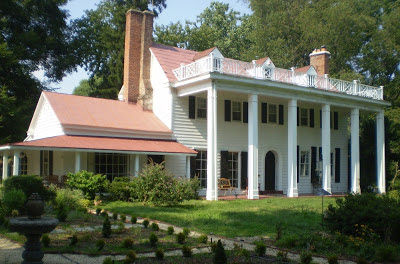The plantation and the Pizza Hut: A suburban county reconsiders its history
 |
| The Oak Hill plantation in Annandale. |
This article is an excerpt from a longer piece in Route Fifty that also discusses the history of the Ilda community in Fairfax.
By Tom Shoop
On Nov. 5, 1861, Pvt. Edward S.E. Newbury and Cpl. Thomas Edwards of the Third Infantry Regiment of the New Jersey Volunteers went on a scouting mission to Oak Hill, a plantation house in Annandale.
They’d heard that a group of Confederates was gathering at the house, whose owner had left the property due to its precarious location in the no man’s land of northern Virginia.
A Civil War incident at Oak Hill
Newbury and Edwards made their way to the house, where they encountered an enslaved Black woman who was tending to her ill son. From her, they learned that the home’s owner was expected to return that evening.
The two men hid in the house’s detached kitchen, and as night fell found themselves in a firefight. Edwards was shot in the back, and he and Newbury fled to a nearby cornfield. Newbury eventually set off to find a source of water.
Along the way, he walked across what is now my not-so-manicured suburban lawn.
Actually, there’s no way to know for sure whether Newbury did or not. But he certainly came close. My wife and I live within easy walking distance of Oak Hill, and an 1862 map indicates the presence of a field where our house now sits – with a yard that backs up to a stream.
Oak Hill, built around 1790, is not lost to history. It’s still standing, although a series of renovations have altered its original look. And it’s still a privately owned and occupied residence – a plantation house smack in the middle of a Fairfax County subdivision.
In 2004, county officials entered into a unique arrangement with Seville Homes, the developer that then controlled the property, under which the county paid $730,000 for a historical easement. It requires the owners of the house to preserve its past, and open it to the public every year.
These “Oak Hill History Days”’ are festive affairs, with costumed volunteers, music, children’s activities and presentations with historical information such as the fact that Thomas Jefferson stayed at the home multiple times during his presidency.
Related story: Annandale history comes to life at Oak Hill
Last year, the open house requirement was met through a video virtual tour due to the pandemic.
“The property is an anomaly within the development of Northern Virginia,” the narrator of the video intones. “This colonial gem is quietly set back from busy roads with 200-year-old boxwood bushes lining a driveway that leads up to the property.”
A reckoning on race
Elsewhere in the video, though, James Walkinshaw, a representative on the Fairfax County Board of Supervisors whose district includes Oak Hill, delivers a more sobering message.
“As we appreciate the architecture of the home and the natural beauty of the site, we also acknowledge that human beings were held here in bondage,” he says. Walkinshaw then reads the names of 41 enslaved people.
The United States is in the midst of an awakening about its history, especially when it comes to issues of race. That’s playing out at the national level, in state capitals, at county and municipal government offices, and at sites like Oak Hill and at Ilda, another historic community nearby whose centerpiece was eventually replaced by a Pizza Hut.
Fairfax County officials have pledged to add more Black voices to its story. That won’t be easy and will require a new approach to how its history is researched and interpreted.
Unrecorded history
For hundreds of years, the light has shone largely on the white experience in America. For example, the story of what happened to Newbury and Edwards is so fully documented that it can be difficult to reconcile the details in conflicting accounts.
It does seem clear that after their encounter with Confederate soldiers at Oak Hill, they hid out in the cornfield until 4 a.m. Then Newbury hoisted Edwards onto his back and began a long trek back to their camp in Alexandria, where they arrived around 7 p.m.
But what about the enslaved woman who had helped them? Her name, that of her ailing son, and the story of how they came to find themselves alone at a plantation house in a hotly contested region during the early days of the Civil War weren’t erased. They weren’t considered significant enough to record at all.
Tom Shoop is editor at large at Route Fifty.
